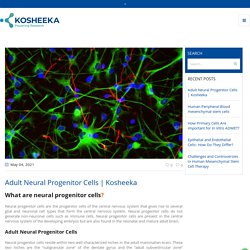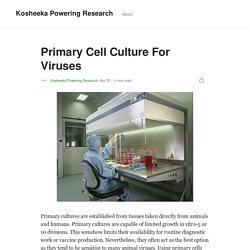

Stemcells
Things To Learn About Primary Cell Cultures. With the advancements made in primary cell cultures technique, cell culture studies provide a valuable complement to in vivo experiments and offer several advantages, such as cost effective, provide an unlimited material supply and bypass ethical concerns associated with the use of animal.

In vitro studies allow more controlled experiments to study cellular functions and processes. For cell culture experiments, cells can be removed directly from the tissue and disaggregated by enzymatic or mechanical means before cultivation, or may be derived from an established cell line. The experiments performed with primary cells are gaining more popularity in research as they provide more meaningful data.
Adult Neural Progenitor Cells. What are neural progenitor cells?

Neural progenitor cells are the progenitor cells of the central nervous system that gives rise to several glial and neuronal cell types that form the central nervous system. Neural progenitor cells do not generate non-neuronal cells such as immune cells. Primary Cell Culture For Viruses. Primary cultures are established from tissues taken directly from animals and humans.

Primary cultures are capable of limited growth in vitro-5 or 10 divisions. This somehow limits their availability for routine diagnostic work or vaccine production. Nevertheless, they often act as the best option as they tend to be sensitive to many animal viruses. Using primary cells derived from the same species as that providing the samples is a common practice in the case of veterinary diagnostic virology. Get Customized human primary cells. Buy Kidney Epithelial Cells (Nephropathy) Things To Learn About Primary Cell Cultures.
How Do Primary Cells Differ From Continuous Cell Lines? The life science research has taken a major turn with the introduction of cell lines and culturing techniques.

A number of experiments are performed with cell lines in order to understand the behaviour of primary and continuous cell lines under different conditions that provide valuable complement to in vivo experiments and play a critical role in scientific advancements. Researchers prefer to use cell lines in experiments as they are generally highly proliferative and easy to culture and transfect. However researchers need to be very cautious when interpreting data generated from cell lines due to limitations associated with cell lines such as modified phenotype, genetic make-up, chromosome aberrations etc. These shortcomings inclined researchers to adopt the primary cells in their research experiments. Human Peripheral Blood mesenchymal stem cells - Kosheeka. Mesenchymal stem cells are easily isolated from bone marrow and other body tissues, such as adipose, umbilical cord, and peripheral blood.

All mesenchymal stem cells have a multipotent differentiation capacity into a variety of cell types, like osteoblasts, chondrocytes, adipocytes, and myoblasts. Human circulating mesenchymal stem cells, also called human peripheral blood mesenchymal stem cells, were initially discovered as fibroblast-like cells. Usually, these cells exist in less population in healthy individuals, but under pathological conditions, circulating peripheral blood mesenchymal stem cells are increased.